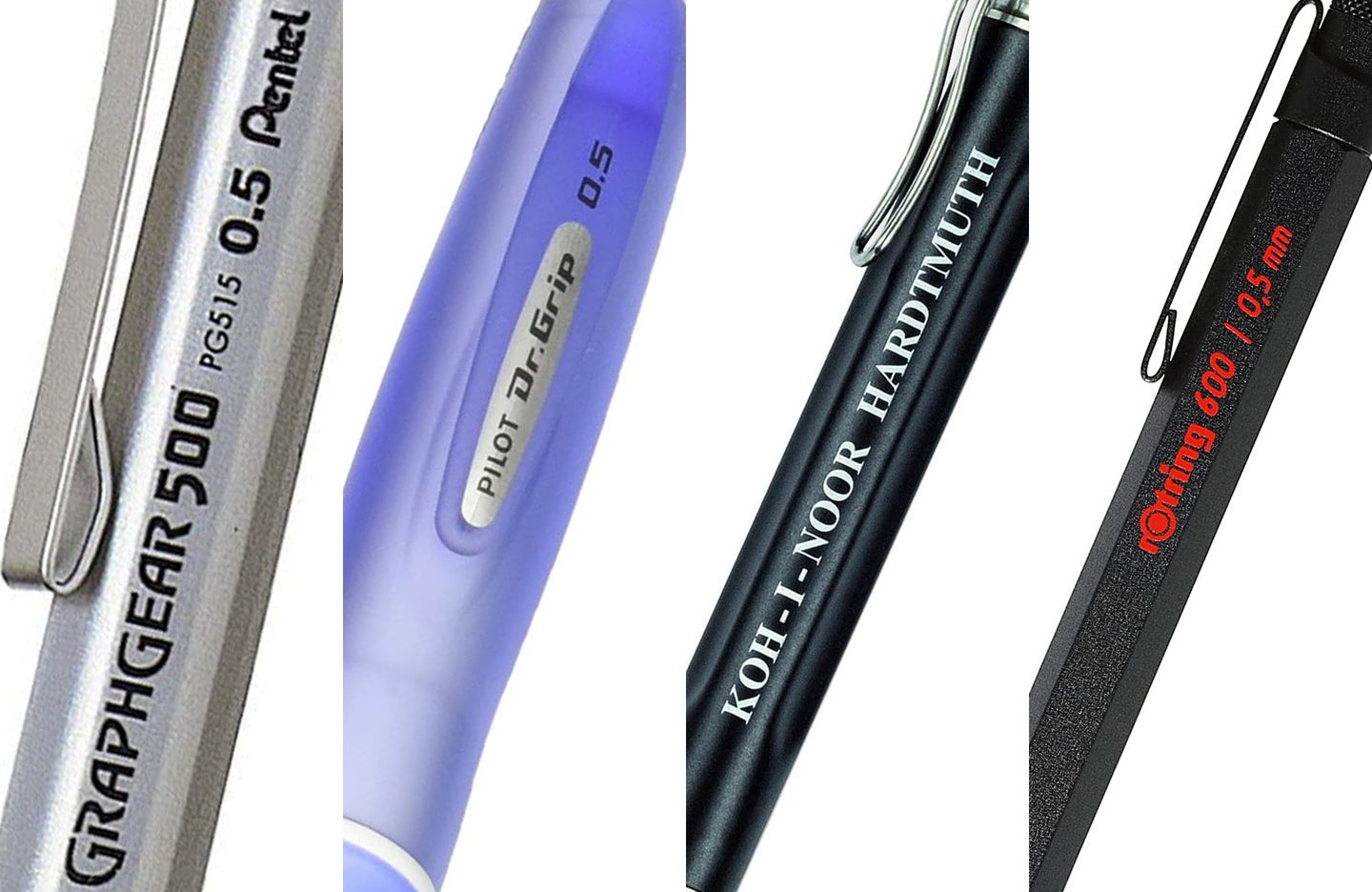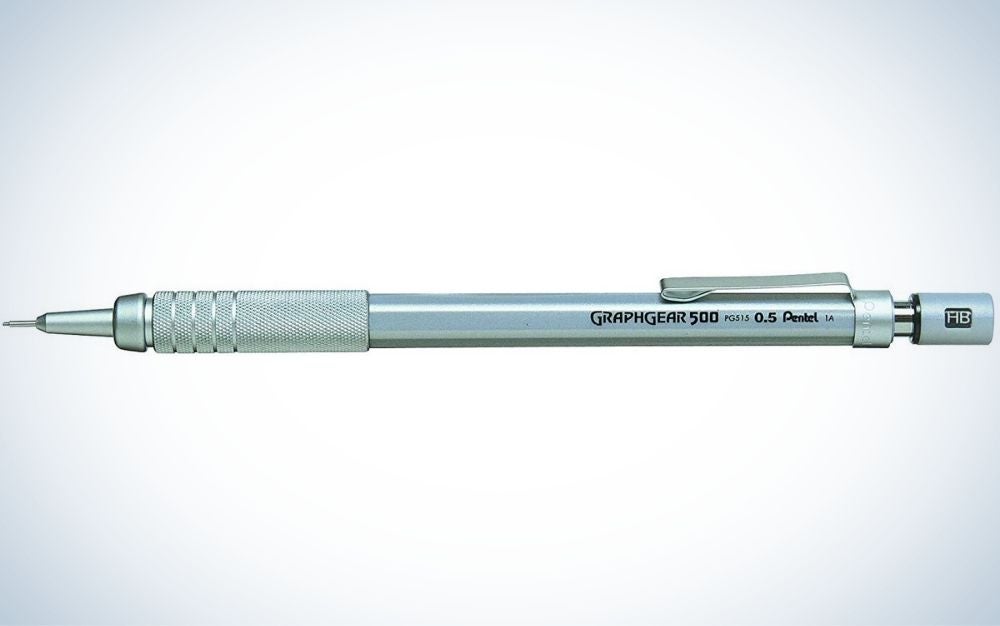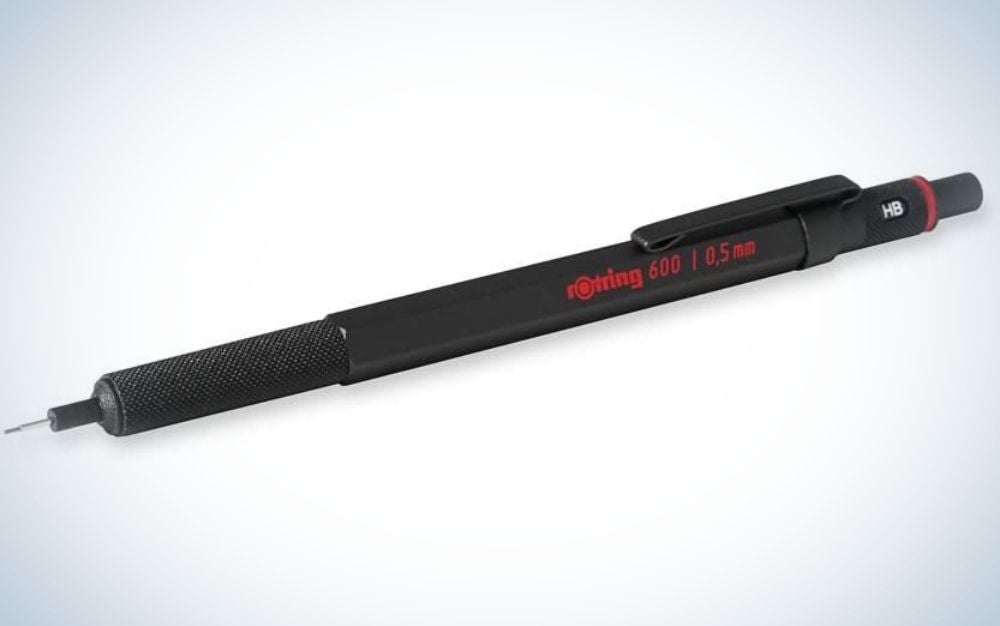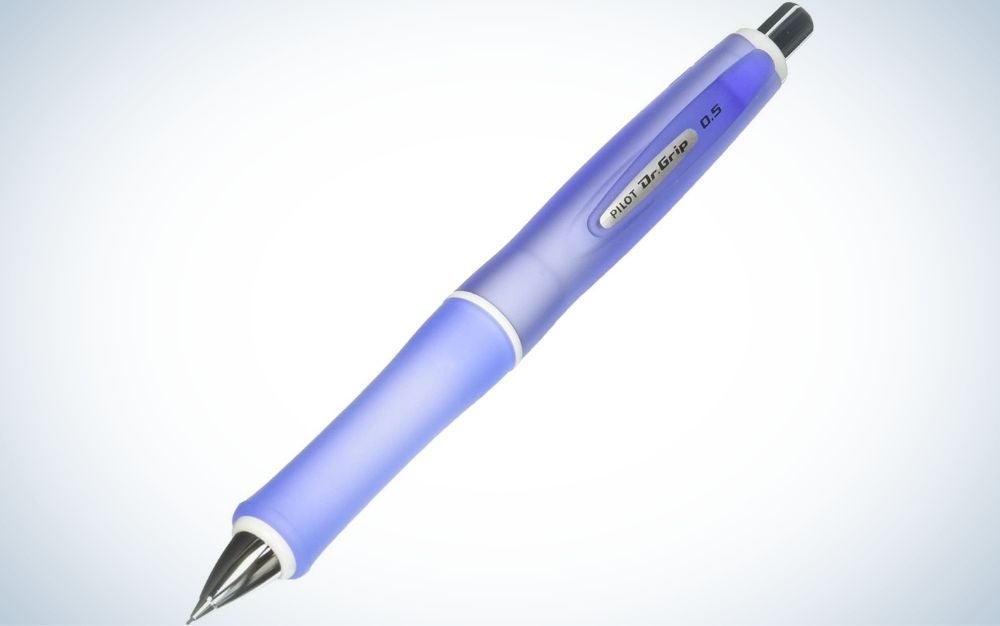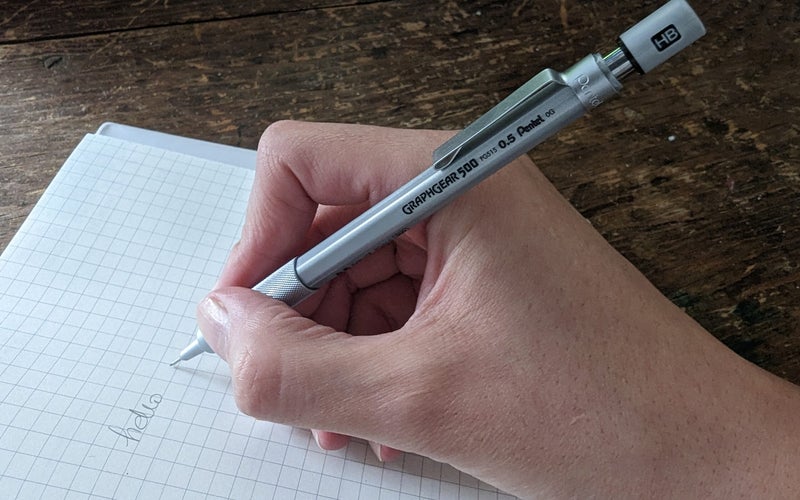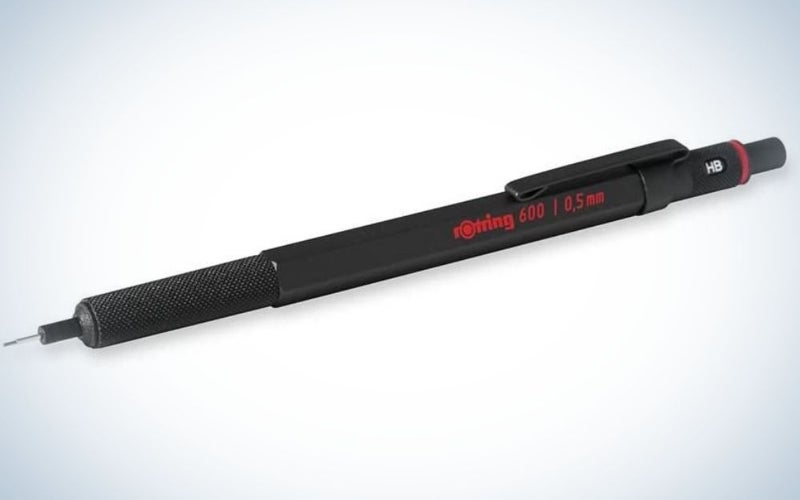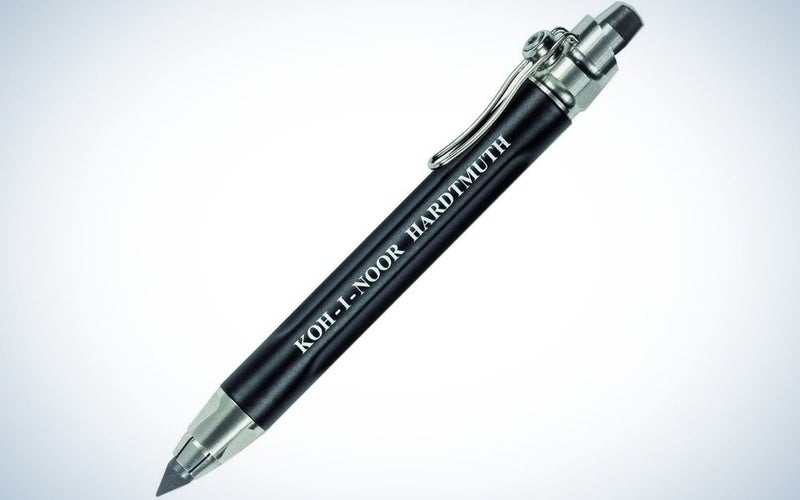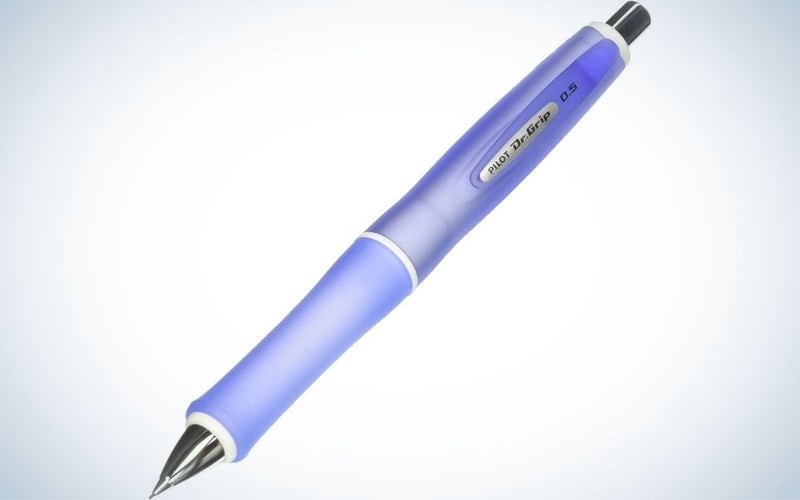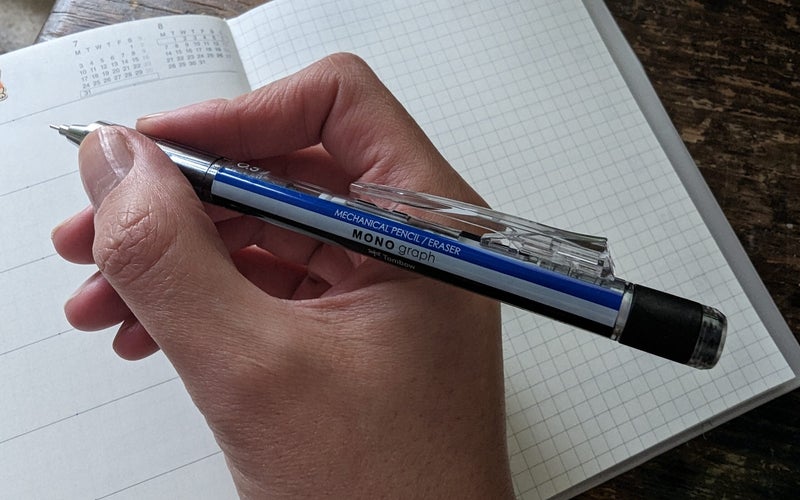We may earn revenue from the products available on this page and participate in affiliate programs. Learn more ›
If you’re an artist, an architect, or a person who prefers much more analog note-taking, chances are you have at least one mechanical pencil in your arsenal. These tools are versatile little pieces of engineering that come in a wide range—from the most basic plastic designs to more sophisticated, metallic models. Not all writing tools are created equal, and diving into a market as varied as this one can certainly be overwhelming. Worry not—even though the best pencil for you will ultimately depend on what you particularly like, there are certain specs you need to look out for. In the meantime, here are our picks for the best mechanical pencils.
- Best overall: Pentel GraphGear 500
- Best for precision: rOtring 600 Black Barrel Mechanical Pencil
- Best for drawing: Koh-i-Noor Mechanical Hardtmuth Lead Holder
- Best ergonomic design: Pilot Dr. Grip G-Spec Shaker Mechanical Pencil
- Best budget: Tombow MONO Graph
How we chose the best mechanical pencils
Newcomers to the pencil world might get their senses saturated with the sheer amount of mechanical pencils available in the market right now. After all, a pencil is a pencil. Except that it’s not. That’s why we scoured the internet, including office-supply stores and specialized sites, to see what’s out there, read dozens of user reviews, and tried product after product to find the best one in each category. To make decisions easier, we broke down the winners based on different factors—best overall, best value, precision, best for art and drawing, best comfort, etc. Whatever your favorite notebook, there’s a mechanical pencil to match.
The best mechanical pencils: Reviews & Recommendations
We considered design and comfort, paying special attention to how these tools feel in your hand and if their weight and girth make it easy to write and draw. We also considered precision, durability, extras such as erasers and rubber grips, and price points. One of our choices should be a perfect match for you.
Best overall: Pentel GraphGear 500
Sandra Gutierrez G.
Why it made the cut: Yes, Pentel already launched the GraphGear 1000, an allegedly better and improved version of this classic mechanical pencil. But the original GraphGear 500 is really all you need—it’s more affordable, reliable, and unlike its successor, still looks like a classic mechanical pencil. There’s a reason why Japanese retailer Muji made their gravity mechanical pencil line look (and feel) exactly like it.
Specs
- Body material: Plastic
- Built-in hardness indicator: Yes
- Sleeve size: 4 mm
- Lead size: 0.3mm, 0.5mm, 0.7mm, and 0.9mm sizes
Pros
- Incredibly durable
- Precise
- Built-in lead hardness indicator
Cons
- Body made of light-duty plastic
- The metallic tip is one piece, so it’s not the easiest to clean
The metallic mesh grip in the GraphGear 500 allows for great control and embeds the pencil with added weight towards the tip, providing a low center of gravity. This feature is super pleasant to the touch and stays cleaner for longer, unlike those gunk-gathering rubber grips. The metal tip also allows for great precision and incredible durability—I’ve been writing and drawing with my GraphGear 500 for over five years, and it still feels like it did on the first day.
The GraphGear 500 releases the lead through a 4mm lead sleeve, which provides greater paper visibility, making it perfect for working on small details or using rulers. This mechanical pencil comes in four different sizes (0.3mm, 0.5mm, 0.7mm, and 0.9mm), and the writing on the barrels is color-coded to reflect that, making it easier to find the exact tool you need for the job. To help with this, the GraphGear 500 also has Pentel’s signature lead grade indicator built into the eraser cap, so you can know exactly what you’ve loaded your pencil with at all times.
No matter how many iterations of this pencil are out there, the original GraphGear 500 is a true classic. If you don’t lose it first, you’ll be putting your ideas on paper for a long time.
Best for precision: rOtring 600 Black-Barrel Mechanical Pencil
Rotring
Why it made the cut: In 1989, rOtring established a new benchmark of precision with the launch of the 600-series pencils. These writing tools were designed specifically for technical drawing and durability, a standard that continues today.
Specs
- Body material: Metal
- Built-in hardness indicator: Yes
- Sleeve size: 4 mm
- Lead size: 0.5mm and 0.7mm
Pros
- Extremely durable
- Lead hardness indicator
- Gnarled grip
Cons
- Expensive
- Hefty
- Non-retractable lead sleeve
The rOtring mechanical pencil can easily last you a lifetime. It’s designed with a full metal body that gives it its 0.8-ounce weight heft. This provides a clear center of gravity, which results in cleaner, more precise lines. Still, this mechanical pencil is more than twice as heavy as the Pentel GraphGear 500, so if you’re not used to this weight, it may take you a bit longer to get used to it.
In addition, the hexagonal shape of the rOtring 600 prevents it from rolling if you’re using an inclined surface and makes it easier on your hands to draw or write for hours. The gnarled metallic grip is comfortable, making it easy to hold the pencil without slipping. A lead guidance sleeve helps prevent breakage and gives you an unobstructed view of the page, perfect for working out details. Finally, the rOtring 600 has a brass internal mechanism that provides high precision in lead advancement. This means the pencil will push the same length of lead with every press of the button and will keep the lead in place regardless of the pressure you apply.
Best for drawing: Koh-i-Noor Mechanical Hardtmuth Lead Holder
KOH-I-NOOR
Why it made the cut: OK, technically, a lead holder is not a mechanical pen, but it shares enough characteristics that it can pass as one. The Koh-i-Noor Mechanical Hardtmuth Lead Holder is a must-have if you don’t want to get your hands dirty while you sketch.
Specs
- Body material: Metal
- Built-in hardness indicator: Unknown
- Sleeve size: Unknown
- Lead size: 5.6mm x 80mm leads
Pros
- Durable
- Thick and steady
- Full metal body
Cons
- Little control over lead advancement
- Short
- Hefty
At only 4-and-a-half inches long, the Koh-i-Noor Mechanical Lead Holder may be a little short, but it’s thick enough to provide great grip and control. Its inner metallic mechanism holds 5.6mm leads in place no matter how far out you’re using it—you won’t be able to push it or twist it without engaging the push button. This feature can easily make up for the short length of the barrel if you need to handle your pencil from a greater distance.
The full metal body of the Hardtmuth gives it an impressive 1.48-ounce weight—this can be a problem if you’re not used to such a chunky tool, but it’ll be right up your alley if you need a lower center of gravity for your sketching and shading. And the metal clip on the Koh-i-Noor Mechanical Hardtmuth Lead Holder is also sturdy, so you can take it anywhere you want without fear of losing it.
Best ergonomic design: Pilot Dr. Grip G-Spec Shaker Mechanical Pencil
PILOT
Why it made the cut: Pilot’s Dr. Grip line was created to reduce fatigue and enhance comfort while writing. The ergonomic design behind the Dr. Grip G-Spec mechanical pencil makes writing for hours a breeze.
Specs
- Body material: Plastic
- Built-in hardness indicator: Unknown
- Sleeve size: Unknown
- Lead size: 0.5mm and 0.7mm
Pros
- Designed for comfort
- Affordable
- Shaker mechanism
Cons
- All plastic body
- Bulky
- Lightweight
If you take a lot of notes every day, then you can’t go wrong with the Pilot Dr. Grip G-Spec Shaker mechanical pencil. Its ergonomic design consists of a thick body and a rubber grip with a soft inner layer and harder outer layer that provides stability and comfort even after hours and hours of writing.
Just like the Tombow, the Dr. Grip features a shaker mechanism that pushes the lead down the barrel when you shake the pencil up and down. You can also advance the lead the traditional way by pressing the push button on the top, so you always have the option depending on what you find most comfortable at the time.
The Dr. Grip comes in various cool colors, including frost red and frost blue. It comes with an eraser at the top that’s refillable. The body is entirely made out of plastic, so it may not be the most durable mechanical pen, but the forgiving design of this pencil makes it very much worth it if you suffer from pain in your wrists and joints.
Best budget: Tombow MONO Graph
Sandra Gutierrez G.
Why it made the cut: The Tombow MONO graph mechanical pencil is a durable, affordable writing tool full of features you won’t have to splurge on.
Specs
- Body material: Plastic body, metallic tip
- Built-in hardness indicator: Unknown
- Sleeve size: Unknown
- Lead size: 0.5mm and 0.7mm
Pros
- Lead lock
- Shaker mechanism
- Twist eraser
- Affordable
Cons
- Full plastic body
- No grip
- Weak clip
- Non-retractable lead sleeve
Tombow is well-known among artists and stationery enthusiasts for its brush pens and markers, and the Japanese company has also developed its own line of mechanical pencils and erasers under the brand MONO. Their signature MONO graph is a comprehensive writing and drawing tool that will give you a lot of bang for your buck.
It’s designed with a shaker mechanism that pushes the lead out when you move the pencil rapidly up and down. This feature is very convenient, as it doesn’t require changing your grip on the pencil. If you’re too used to using your thumb to push the lead, you can use the clip as a push button. To avoid mishaps, you can also push the clip up to block the mechanism altogether. This is perfect for storage, as you won’t have to worry about lead breakage.
Another great feature of the MONO graph is its eraser, which you can twist in and out easily. The eraser is over an inch long, and you can buy eraser refills, so you’ll always be able to fix your mistakes.
The body of the Tombow MONO graph is almost entirely made out of plastic, which is something some people don’t like. Still, the material is durable, and the body is on the thicker side, so the pencil has a certain heft that provides control and comfort. The tip is made from a light metallic alloy, and the lead sleeve is not retractable, which may be a bother if you carry the MONO graph in your pocket.
What to consider when buying the best mechanical pencils
Not all mechanical pencils will fit your needs. Although we can’t help you become a better writer, we can help you point out what makes a great mechanical pencil. Here’s what to know when shopping for the best mechanical pencils:
Size of lead
The first and most important thing to consider before buying a mechanical pencil is the lead size. This will determine the type of lead you can load into the pencil—the lower the number, the finer the lead. Most pencils come in at least two sizes: 0.5 is the most common, followed by 0.7. The size you get will depend on what you’ll be using your pencil for.
Keep in mind when considering leads that you’ll have the widest range of options when you choose a 0.5-size mechanical pencil. If you want to experiment with colored leads, for example, it’s unlikely that you’ll have a lot to choose from in a 0.3 size.
Material
Next, you’ll need to consider the material the pencil is made of. Full metal-bodied pencils are much more durable than ones made totally or partially out of plastic, but they tend to be more high-end, making them heavier and pricier. But that doesn’t mean you’ll compromise quality for a full plastic body. Some of these polymers are thick and durable, while others are cheap and easily breakable. Most of the time, the price point is a great sign of what you’re dealing with, but reading reviews will also help you avoid splurging on a low-quality tool.
Location
Finally, think about where your pencil will live. If you plan to keep it on your computer desk, then you’ll prefer a hexagonal-shaped body to prevent your pencil from rolling off and falling to the floor—possibly to its death or that of the lead within it. If you’ll be folding up your portable desk and carrying around your mechanical pencil in your pocket or in a pencil case, you’re better off with a tool with a retractable lead sleeve. This will avoid lead breakage and the threat of constantly getting stabbed in the thigh or your ribs or poking holes in your pencil case.
FAQs
Q: How much does a mechanical pencil cost?
Depending on body material and features, a mechanical pencil can cost between $7-$30.
Q: Why are mechanical pencils better?
Mechanical pencils aren’t necessarily better than your good ol’ N°2 pencil, but there are some advantages to them. First, you can load different types of lead into the same mechanical pencil, depending on what you need. For example, for a size 0.5 pencil, you can load leads with different grades or levels of hardness (H, HB, B); or with different colors. This means you only need one mechanical pencil to do the job of an entire set of regular pencils. Second, you don’t have to sharpen a mechanical pencil, so they’re always ready for fine lines and meticulous details.
Q: Is 0.5 or 0.7 pencil better?
As with most things regarding pencils, it depends on what you’re doing and what you like. The difference between a 0.5 and a 0.7 is the girth of the lead you load into the pencil. Most of the time, 0.7 leads are softer than most 0.5, but that’s not necessarily true—always check the grade of the lead. H stands for hardness and B for blackness. HB leads balance the two, so if you’re a beginner, this is a great place to start. If you write with big letters, a 0.7 will give you thicker lines and will make your handwriting look better than with a 0.5.
Q: How do I choose a mechanical pencil?
It’ll always depend on what you’ll use the pencil for and what you like. If you use tools like rulers and squares, and you need high precision, your best bet is to go for a low-gravity mechanical pencil with a long lead sleeve. If whatever you do calls for constant erasing, a 0.3 mechanical pencil may be too sharp and might eventually damage the paper you’re working on. Your best bet is a comfortable 0.5 mechanical pencil loaded with an HB lead. If, however, you want to use your tool for drawing and your style requires shading, a thick 0.9 mechanical pencil with a big eraser might be the solution for you, as it’ll give you a lot more range of shades. The best way to find a mechanical pencil is to try as many as you can. And once you find something you like, buy more than one so you don’t have to lament the loss of your beloved favorite mechanical pencil.
Final thoughts on the best mechanical pencils
- Best overall: Pentel GraphGear 500
- Best for precision: rOtring 600 Black Barrel Mechanical Pencil
- Best for drawing: Koh-i-Noor Mechanical Hardtmuth Lead Holder
- Best ergonomic design: Pilot Dr. Grip G-Spec Shaker Mechanical Pencil
- Best budget: Tombow MONO Graph
It may not seem like it, but the writing or drawing tools you choose to use are our very personal decisions. They don’t necessarily have to be pricey, highly specialized mechanical pens. Depending on what kind of work you do, if you’re on the move a lot, and whether you prefer heavier or lighter tools, your perfect mechanical pencil may not even be among our picks. Still, if you’re new to the wide and varied world of writing instruments, you definitely will not go wrong by choosing any of the items on this list.
And whenever you find something you truly like, stick with it. We recommend purchasing a couple of extra pencils to have in storage, just in case yours gets misplaced, discontinued, or you use it so much it falls apart in your hands—not a bad way to go.
Why trust us
Popular Science started writing about technology more than 150 years ago. There was no such thing as “gadget writing” when we published our first issue in 1872, but if there was, our mission to demystify the world of innovation for everyday readers means we would have been all over it. Here in the present, PopSci is fully committed to helping readers navigate the increasingly intimidating array of devices on the market right now.
Our writers and editors have combined decades of experience covering and reviewing consumer electronics. We each have our own obsessive specialties—from high-end audio to video games to cameras and beyond—but when we’re reviewing devices outside of our immediate wheelhouses, we do our best to seek out trustworthy voices and opinions to help guide people to the very best recommendations. We know we don’t know everything, but we’re excited to live through the analysis paralysis that internet shopping can spur so readers don’t have to.
